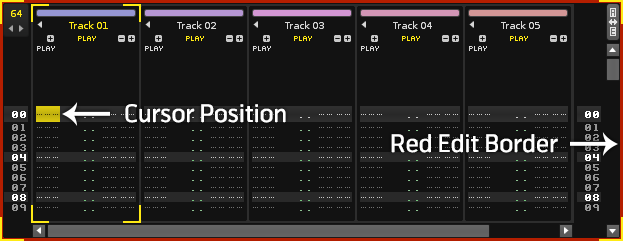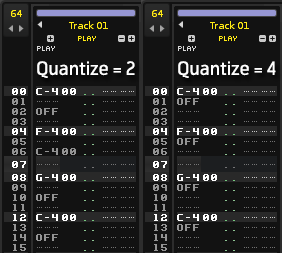Recording and Editing Notes: Difference between revisions
imported>Achenar No edit summary |
imported>Achenar No edit summary |
||
| Line 3: | Line 3: | ||
There are two ways of recording notes in Renoise (Redux only uses Step By Step): | There are two ways of recording notes in Renoise (Redux only uses Step By Step): | ||
* '''Step By Step:''' Enter and edit notes manually with the [[Playing_Notes_with_the_Computer_Keyboard |computer keyboard]] or a MIDI keyboard, step by step. This can be done while the song is stopped or while it's playing back. | |||
* '''Live Recording:''' Record what you are playing "live", as the song is playing back. This is how most sequencers record notes. | * '''Live Recording:''' Record what you are playing "live", as the song is playing back. This is how most sequencers record notes. | ||
== Edit Mode == | == Edit Mode == | ||
First, in order to be able to record anything, make sure that Edit Mode is enabled by pressing the ''"ESC"'' key on your keyboard. Alternatively, in Renoise you can click the record button in the [[Transport Panel]], while in Redux there are two options in the [[Phrase Editor]]: the [[Phrase_Editor#Phrase_Properties|Edit button]] at the bottom left and the 'edit on/off' area at the top right. | First, in order to be able to record anything, make sure that Edit Mode is enabled by pressing the ''"ESC"'' key on your keyboard. Alternatively, in Renoise you can click the record button in the [[Transport Panel]], while in Redux there are two options in the [[Phrase Editor]]: the [[Phrase_Editor#Phrase_Properties|Edit button]] at the bottom left and the 'edit on/off' area at the top right corner of the phrase. | ||
The red border around the Pattern/Phrase Editor indicates that Edit Mode has been activated and inputs will now be recorded at the cursor position: | The red border around the Pattern/Phrase Editor indicates that Edit Mode has been activated and inputs will now be recorded at the cursor position: | ||
[[image:3.0_recording-editborder.png]] | [[image:3.0_recording-editborder.png]] | ||
== Entering Notes Step By Step == | |||
To record notes step by step, simply play notes with Edit Mode enabled. The note will be inserted into the Note column at the current cursor position and the cursor will move downwards within the editor. The amount of lines that the cursor moves by can be changed with the Edit Step parameter, which can even be set to zero. The Edit Step value box is found in Renoise at [[Pattern Editor#Pattern Editor Control Panel|the bottom of the Pattern Editor]] or at the top of the [[Phrase_Editor#Phrase_Editor_Options|Phrase Editor]]. In Redux, it is found at the bottom left corner of the phrase. | |||
You can also record notes step by step while the song/phrase is playing, though when doing this in the Renoise [[Pattern Editor]], ensure that [[Transport Panel|Pattern Follow]] is disabled to decouple the cursor from the playback position. | |||
'''Shortcut:''' To quickly change the Edit Step value you can use ''"Left Ctrl + 1,2,3,4,5,6,7,8,9,0"''. | |||
| Line 20: | Line 29: | ||
To record notes "live": | To record notes "live": | ||
# | # Turn Pattern Follow ''ON'' [[Image:3.0_transportpanel-patternfollowon.png|text-bottom]] in the [[Transport Panel]] (or use the ''"Scroll Lock"'' key), which couples the cursor to the playback position. | ||
# Start the song playing with Edit Mode enabled. | # Start the song playing with Edit Mode enabled. | ||
# Play notes with the computer keyboard or your MIDI master keyboard. | # Play notes with the computer keyboard or your MIDI master keyboard. | ||
| Line 33: | Line 42: | ||
= | === Real-time and Manual Quantization === | ||
== Real-time and Manual Quantization == | |||
When recording notes "live", by default they will be recorded with the highest possible precision using the [[Pattern_Editor#Columns|Note Delay]] sub-column in the [[Pattern Editor]]. The note delay column allows you to delay notes with a precision of 1/256th of a line. | When recording notes "live", by default they will be recorded with the highest possible precision using the [[Pattern_Editor#Columns|Note Delay]] sub-column in the [[Pattern Editor]]. The note delay column allows you to delay notes with a precision of 1/256th of a line. | ||
| Line 63: | Line 57: | ||
== Polyphonic vs. Monophonic Recording == | == Polyphonic vs. Monophonic Recording == | ||
The Mono button | Sequential (monophonic) recording can often be better when recording drums or monophonic instruments. The Mono button allows you to toggle between recording a single note at a time or multiple notes simultaneously (chords). This is located in the Instrument Properties panel, found at the [[Redux_main_screen#Instrument_Properties|top right of the interface]] in Redux and [[Instruments#Instrument Properties|near the top right]] while in the [[Sampler]], [[Plugin]] and [[MIDI]] tabs of Renoise. | ||
== Entering Chords with the Computer Keyboard == | == Entering Chords with the Computer Keyboard == | ||
When entering notes step by step with the computer keyboard, | When entering notes step by step with the computer keyboard, they will by default be placed sequentially. If you want to quickly insert chords without live recording, you can do this by holding down ''"Left Shift"'' while entering the notes. This will automatically create columns to the right and enter the new notes there. | ||
Note that MIDI keyboards will always record chords when pressing more than one key at a time. | Note that MIDI keyboards will always record chords when pressing more than one key at a time. | ||
Revision as of 09:54, 4 June 2015
Recording and Editing Notes
There are two ways of recording notes in Renoise (Redux only uses Step By Step):
- Step By Step: Enter and edit notes manually with the computer keyboard or a MIDI keyboard, step by step. This can be done while the song is stopped or while it's playing back.
- Live Recording: Record what you are playing "live", as the song is playing back. This is how most sequencers record notes.
Edit Mode
First, in order to be able to record anything, make sure that Edit Mode is enabled by pressing the "ESC" key on your keyboard. Alternatively, in Renoise you can click the record button in the Transport Panel, while in Redux there are two options in the Phrase Editor: the Edit button at the bottom left and the 'edit on/off' area at the top right corner of the phrase.
The red border around the Pattern/Phrase Editor indicates that Edit Mode has been activated and inputs will now be recorded at the cursor position:
Entering Notes Step By Step
To record notes step by step, simply play notes with Edit Mode enabled. The note will be inserted into the Note column at the current cursor position and the cursor will move downwards within the editor. The amount of lines that the cursor moves by can be changed with the Edit Step parameter, which can even be set to zero. The Edit Step value box is found in Renoise at the bottom of the Pattern Editor or at the top of the Phrase Editor. In Redux, it is found at the bottom left corner of the phrase.
You can also record notes step by step while the song/phrase is playing, though when doing this in the Renoise Pattern Editor, ensure that Pattern Follow is disabled to decouple the cursor from the playback position.
Shortcut: To quickly change the Edit Step value you can use "Left Ctrl + 1,2,3,4,5,6,7,8,9,0".
Live Recording (Renoise Pattern Editor Only)
To record notes "live":
- Turn Pattern Follow ON
 in the Transport Panel (or use the "Scroll Lock" key), which couples the cursor to the playback position.
in the Transport Panel (or use the "Scroll Lock" key), which couples the cursor to the playback position. - Start the song playing with Edit Mode enabled.
- Play notes with the computer keyboard or your MIDI master keyboard.
The played notes will now be recorded into the track at the current playback position in the Pattern Editor.
Tips
- To enable Edit Mode and start playing with a single button press, you can also use the "Right Shift" key.
- To just start playing, you can use either the "Spacebar" or "Right Ctrl".
- Pressing the "Right Alt" key will start playing, but also with looping of the current pattern enabled.
- To enable a count-in for live recording, turn on the Metronome pre-count via the Options menu in the Upper Status Bar. You can also adjust the amount of bars the count-in lasts here.
Real-time and Manual Quantization
When recording notes "live", by default they will be recorded with the highest possible precision using the Note Delay sub-column in the Pattern Editor. The note delay column allows you to delay notes with a precision of 1/256th of a line.
If you do not want to precisely record your notes, you can let Renoise quantize them either in real-time or after recording something. This is done with the quantize controls in the Pattern Editor control bar:
The "Q" button enables or disables live quantization, while the value box to the right specifies the quantization value in lines. Use the drop down menu next to the value box to manually quantize a range within the current pattern after recording.
Polyphonic vs. Monophonic Recording
Sequential (monophonic) recording can often be better when recording drums or monophonic instruments. The Mono button allows you to toggle between recording a single note at a time or multiple notes simultaneously (chords). This is located in the Instrument Properties panel, found at the top right of the interface in Redux and near the top right while in the Sampler, Plugin and MIDI tabs of Renoise.
Entering Chords with the Computer Keyboard
When entering notes step by step with the computer keyboard, they will by default be placed sequentially. If you want to quickly insert chords without live recording, you can do this by holding down "Left Shift" while entering the notes. This will automatically create columns to the right and enter the new notes there.
Note that MIDI keyboards will always record chords when pressing more than one key at a time.

